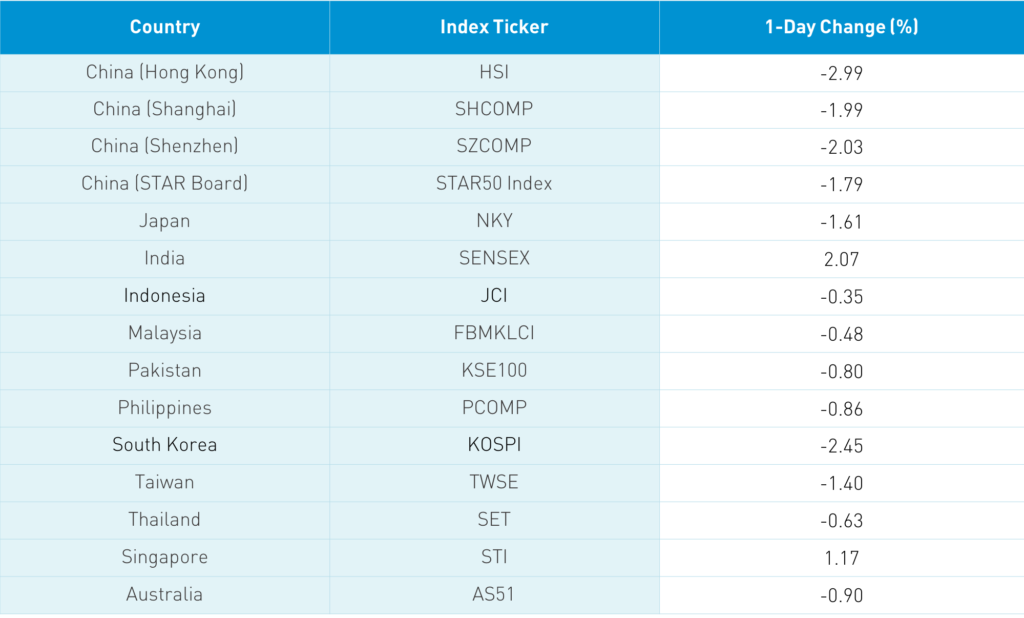No Place To Hide As Pullback Continues
3 Min. Read Time
Key News
Asian equities were thoroughly rinsed as most markets were off within -2% to -3%. However, India and Singapore were significant outliers to the upside. Growth stocks followed their US equivalents lower as investors worry about rising US Treasury yields and inflation.
Asia-based brokers noted the tough China talk from US Treasury Deputy Secretary appointee Wally Adeyemo in his confirmation hearing. They also noted US Senate Majority Leader Chuck Schumer proposing legislation to “out-compete China and create new American jobs” by providing financial support to US technology companies. I believe Mr. Adeyemo’s comments were simply playing to the Congressional crowd. On the second point, considering the market cap of US technology companies, would anyone believe that they need help? The previous administration used China as a distraction technique. It’s disappointing that this isn’t more broadly recognized. The offshore Renminbi, China’s currency that trades during US hours, appreciated slightly, indicating that these comments are unlikely to hold weight.
Adding insult to injury, Hong Kong announced the stock trading stamp tax will be increased by 0.1% to 0.13%. Yesterday I mentioned the rumor that this might happen, which came in light of FTSE announcing their indexes will move from Alibaba’s US share class to the company’s Hong Kong share class in March. I will be reaching out to MSCI today to lobby not to move to the Hong Kong share class due to the higher cost of trading. The stamp tax was a significant negative catalyst for the market in general and Hong Kong Exchanges’ stock in particular, which fell -8.78% despite reporting strong earnings today. The Hong Kong government’s finances are a disaster though I highly doubt stamp tax revenue will help as spreads widen and volumes decline.
The Hang Seng Index opened higher though quickly began to descend to close -2.99%, below the 30k level, at 29,671 on one of the highest volume days ever. Within the broader Hang Seng Composite, there were only 60 advancers versus 418 decliners and all sectors were in the red, i.e. there was no place to hide. Volume leaders, based on the value of volume traded, included Tencent, which fell -2.83%, Hong Kong Exchanges, which fell -8.78%, Meituan, which fell -6.87%, Xiaomi, which fell -4.45%, Alibaba HK, which fell -1.94%, China Mobile, which fell -1.97%, BYD, which fell -5.94%, CNOOC, which fell -7.31%, Kuaishou Technology, which fell -8.6%, and Ping An Insurance, which fell -1.25%. Within the top 50 highest volume stocks, there were only two stocks that were up, one of which was Sino Biopharma, which gained +2.53% on their vaccine rollout. Southbound Stock Connect did not help either as Mainland investors sold $2.57 billion worth of Hong Kong stocks in one of the largest net sale days since the inception of the connect program.
Mainland China was off as well as Shanghai, Shenzhen, and the STAR Board fell -1.99%, -2.03%, and -1.79%, respectively. Breadth in Mainland China was better with more advancers than decliners. Meanwhile, real estate actually managed a positive return. Nonetheless, it was ugly as the Year of the Ox has not had a great start. Foreign investors sold -$104 million worth of Mainland stocks via Northbound Stock Connect while CNY appreciated slightly versus the US dollar, bonds rallied, and copper rallied.
Where do we go from here? The charts are still in an uptrend though we are seeing a pullback, which is always painful both emotionally and financially. The Shenzhen Composite Index is currently at the lower end of its short-term chart, which should provide support. I cannot predict the future, but I believe many investors are under-allocated to emerging markets and China, providing a nice entry point.
I was asked yesterday about the status of China ETFs. US-listed China ETFs have $28 billion of AUM versus US-listed emerging markets ETFs, which have a total of $246 billion. China making up 40% of emerging markets means China ETFs should have $98 billion.
Bilibili reports after the US close today.
Weibo’s Hong Kong IPO might come later than anticipated, but within the year to be sure.


H-Share Update
The Hang Seng opened higher but quickly started a descent to close -2.99% at 29,718. Volume increased +31.9%, which is 239% of the 1-year average, while breadth saw 10 advancers and 41 decliners. The 196 Chinese companies listed in Hong Kong and within the MSCI China All Shares Index lost -2.58% led by discretionary -5.75%, tech -5.74%, materials -4.4%, health care -3.71%, staples -3.58%, energy -2.9%, communication -2.87%, financials -2.34%, industrials -2.21%, real estate -2.17%, and utilities -2.13%. Southbound Stock Connect volumes were elevated as Mainland investors sold $2.573 billion worth of Hong Kong stocks today and Southbound trading accounted for 15.6% of Hong Kong turnover.
A-Share Update
Shanghai and Shenzhen also opened higher before heading down the rabbit hole to close -1.99% and -2.03% at 3,564 and 2,347, respectively. Volume increased +4% from yesterday, which is 122% of the 1-year average while breadth saw 1,926 advancers and 1,870 decliners. The 511 Mainland stocks within the MSCI China All Shares Index lost -2.62% with real estate +0.21% while staples -4.28%, materials -4.16%, health care -3.73%, discretionary -3.01%, industrials -3%, energy -2.11%, financials -1.14%, tech -0.98% communication -0.57% and utilities -0.39%. Northbound Stock Connect volumes were elevated as foreign investors sold $104 million worth of Mainland stocks as Northbound Connect trading accounted for 7.9% of Mainland trading.
Last Night’s Exchange Rates, Prices, & Yields
- CNY/USD 6.46 versus 6.37 yesterday
- CNY/EUR 7.84 versus 7.86 yesterday
- Yield on 1-Day Government Bond 1.42% versus 1.47% yesterday
- Yield on 10-Year Government Bond 3.26% versus 3.26% yesterday
- Yield on 10-Year China Development Bank Bond 3.74% versus 3.74% yesterday















